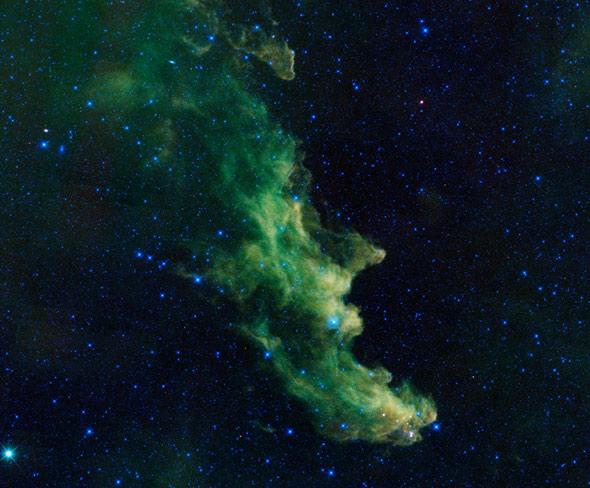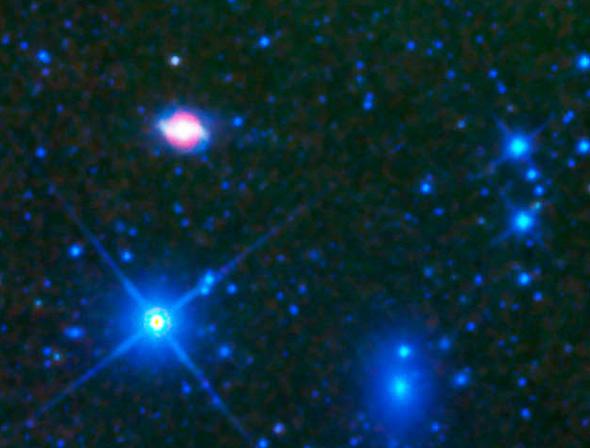I know Halloween was a while back, but an image released by NASA came a bit too late for me to put up on the blog here. And while I’ve talked about this particular object before, it was taken by a different observatory, and features some stuff I hadn’t seen before!
OK, enough being cryptic. Here’s the image, the spooky-famous Witch Head Nebula:

Photo by NASA/JPL-Caltech
Isn’t that cool! And it really looks like a witch’s face, looking to the right. This may look like the picture I posted as part of my Halloween gallery, but it’s in fact quite different.
For one thing, this image was taken by WISE (Wide-Field Infrared Survey Experiment), which sees light in the far-infrared, way outside what our eyes can see. The reddest color we see is at a wavelength of about 0.7 microns, but in the WISE image, what’s colored blue is light at a wavelength of 3.4 microns, green is 12 microns, and red is 22 microns. Typically, the red comes from very cold dust, and green is from long, complex chains of organic (carbon-based molecules) called polycyclic aromatic hydrocarbons. Essentially, that’s soot.
This sort of material is very common in places where stars form, and the sculpted, scalloped shape of the Witch’s face is probably due to those young stars having eaten away at the material from which they were born. In visible light, the kind we see, the Witch Head is very blue, probably due to reflected light from Rigel, the brightest star in Orion and an incredibly luminous powerhouse. You can also see a magnificent shot of it showing all of Orion as well, taken by Rogelia Andreo, that’s so fantastic I picked it as my #1 picture of the year for 2010.
The original WISE image is huge, 9163 x 9163 pixels, and spectacular. Just perusing it is pretty amazing. I found several stars that are very red, which means they are incredibly cool — literally, cooler than the Sun. These may be old stars surrounded by thick shells of dust that block and absorb the starlight and re-emit is as infrared: what are called carbon stars. Warmer stars like the Sun tend to look blue in WISE images because they put out way more light in that part of the spectrum than in the far infrared.
I got a little surprise when I was scanning the image to the left of the Witch Head. I found a moderately bright galaxy with lovely spiral arms, but the center of the galaxy was glowing fiercely red:

Photo by NASA/JPL-Caltech
At first, I thought this might be an active galaxy, one where the central supermassive black hole (which every big galaxy has) was actively gobbling down matter and blasting out intense radiation. Many such active galaxies are choked with dust and are powerful infrared emitters.
The galaxy core is so bright I decided to track it down. It took a few minutes, but I finally figured out this object is NGC 1720, a barred spiral galaxy about 200 million light years away (the other fuzzy galaxy next to it, down to the lower right, is NGC 1726, and the two might be members of the same group of galaxies).
However, it turns out NGC 1720 is not an active galaxy: it’s a starburst galaxy, which means it recently underwent an extraordinarily period of star formation (like the more familiar and much closer galaxy M82). As I said before, star birth means the creation of lots of dust, and that’s why NGC 1720 is blasting out red light; it’s been more than usually fecund.
I was very pleased to find this object in the WISE image; I enjoy poking through big, high-resolution images, especially when I stumble on something unexpected, but still explainable (and also knowing my instincts that this was a very dusty object were correct). WISE was shut down in 2011, but has now been re-started to look for near-Earth asteroids, which are far easier to spot in the infrared. I’m glad to hear it; WISE can do far more than just look for doomsday rocks — which, I should add, I’m all for finding! — and it’s good to see this wonderful instrument back up and running.